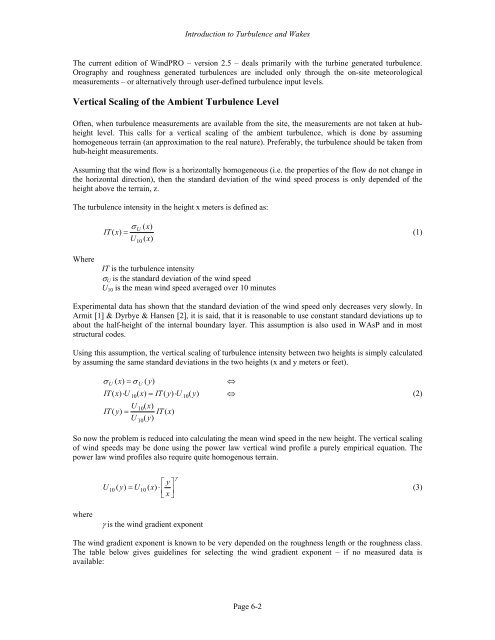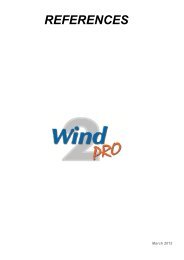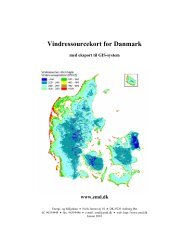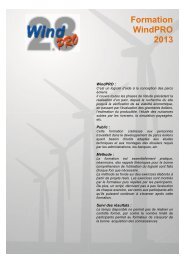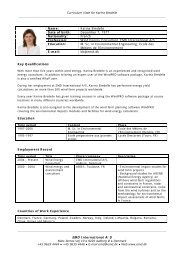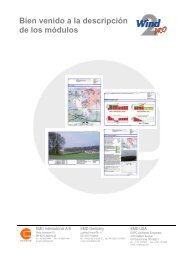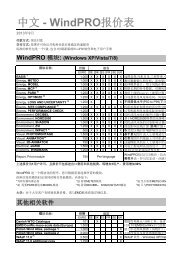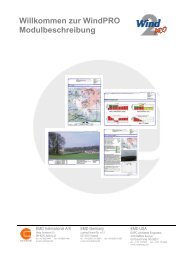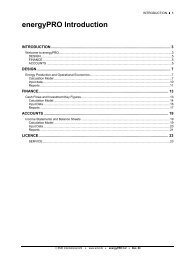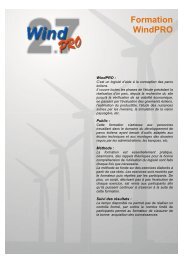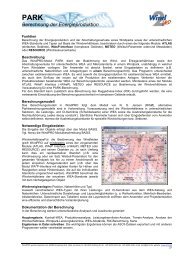WindPRO / PARK - EMD International AS.
WindPRO / PARK - EMD International AS.
WindPRO / PARK - EMD International AS.
You also want an ePaper? Increase the reach of your titles
YUMPU automatically turns print PDFs into web optimized ePapers that Google loves.
Introduction to Turbulence and Wakes<br />
The current edition of <strong>WindPRO</strong> – version 2.5 – deals primarily with the turbine generated turbulence.<br />
Orography and roughness generated turbulences are included only through the on-site meteorological<br />
measurements – or alternatively through user-defined turbulence input levels.<br />
Vertical Scaling of the Ambient Turbulence Level<br />
Often, when turbulence measurements are available from the site, the measurements are not taken at hubheight<br />
level. This calls for a vertical scaling of the ambient turbulence, which is done by assuming<br />
homogeneous terrain (an approximation to the real nature). Preferably, the turbulence should be taken from<br />
hub-height measurements.<br />
Assuming that the wind flow is a horizontally homogeneous (i.e. the properties of the flow do not change in<br />
the horizontal direction), then the standard deviation of the wind speed process is only depended of the<br />
height above the terrain, z.<br />
The turbulence intensity in the height x meters is defined as:<br />
σ U<br />
( x)<br />
IT(<br />
x)<br />
= (1)<br />
U 10 ( x)<br />
Where<br />
IT is the turbulence intensity<br />
σ U is the standard deviation of the wind speed<br />
U 10 is the mean wind speed averaged over 10 minutes<br />
Experimental data has shown that the standard deviation of the wind speed only decreases very slowly. In<br />
Armit [1] & Dyrbye & Hansen [2], it is said, that it is reasonable to use constant standard deviations up to<br />
about the half-height of the internal boundary layer. This assumption is also used in WAsP and in most<br />
structural codes.<br />
Using this assumption, the vertical scaling of turbulence intensity between two heights is simply calculated<br />
by assuming the same standard deviations in the two heights (x and y meters or feet).<br />
σ ( x)<br />
= σ<br />
U<br />
IT(<br />
x)<br />
⋅U<br />
10<br />
U<br />
IT(<br />
y)<br />
=<br />
U<br />
U<br />
( y)<br />
( x)<br />
= IT ( y)<br />
⋅U<br />
10<br />
10<br />
( x)<br />
IT ( x)<br />
( y)<br />
10<br />
( y)<br />
⇔<br />
⇔<br />
(2)<br />
So now the problem is reduced into calculating the mean wind speed in the new height. The vertical scaling<br />
of wind speeds may be done using the power law vertical wind profile a purely empirical equation. The<br />
power law wind profiles also require quite homogenous terrain.<br />
γ<br />
⎡ y ⎤<br />
U 10 ( y)<br />
= U10<br />
( x)<br />
⋅ ⎢ ⎥<br />
(3)<br />
⎣ x ⎦<br />
where<br />
γ is the wind gradient exponent<br />
The wind gradient exponent is known to be very depended on the roughness length or the roughness class.<br />
The table below gives guidelines for selecting the wind gradient exponent – if no measured data is<br />
available:<br />
Page 6-2


